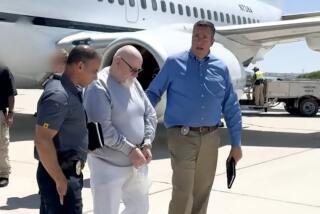LAPD detectives found a killer -- just not the one they were looking for
- Share via
By the time homicide Det. Dennis Kilcoyne met with Diane Webb last fall to discuss the maddening search for a serial killer who has stalked South L.A. for decades, he was wide open to suggestions. Despite more than a year of chasing leads, Kilcoyne and his team of detectives were no closer to catching the man suspected of sexually assaulting and murdering at least 10 young black women.
Webb, who heads a Los Angeles Police Department unit responsible for tracking the whereabouts of sex offenders, suggested a new tack: Though most of the roughly 5,200 sex offenders registered in Los Angeles comply with a requirement to submit DNA samples to authorities for input into state databases, many have slipped through the cracks. The officers in Webb’s group fanned out across the city to track down men who possibly fit the killer’s profile and to collect DNA samples for comparison to evidence left behind by the killer.
The plan worked.
Just not in the way Kilcoyne had intended.
In late March, the California Department of Justice’s DNA laboratory jolted LAPD detectives with news that the saliva collected from 72-year-old John Floyd Thomas Jr., one of the sex offenders contacted by Webb’s officers, matched genetic evidence found at the crime scenes of two Los Angeles women raped and killed in the 1970s. Soon after, Thomas was tied by DNA to three more slayings. Details from those cases matched dozens of other unsolved murders and rapes. The women, however, had been older and white, not black and young.
And Thomas’ DNA didn’t match the man Kilcoyne was hunting.
In looking for one serial killer, the LAPD believes it has stumbled upon another.
The capture of Thomas was one of the biggest by California law enforcement in recent years. Police suspect he is the “Westside Rapist” -- the man who late at night terrorized upscale neighborhoods on the city’s Westside in the 1970s, breaking silently into the homes of women who lived alone and raping and strangling them. The violence stopped when Thomas was sent to prison for a rape and started again in Claremont a decade later, shortly after Thomas was released and moved to the area, according to police. At the time of his release, authorities did not keep DNA databases.
Thomas is scheduled to be arraigned in August on two murder charges. LAPD Det. Richard Bengston, who is handling the case with his partner, acknowledged in an interview that DNA evidence from several of Thomas’ other suspected crime scenes is not as definitive, but said he expects the LAPD and the L.A. County Sheriff’s Department to file additional murder charges.
In addition to the 12 known Westside slayings in the mid-1970s that police say fit Thomas’ profile, Bengston said his recent review of files from the early part of the decade turned up 15 more suspected cases. Files from the previous decade will probably contain more, he said. Because of insufficient evidence, not all will lead to formal charges, but police say they believe they ultimately will be able to close more than 30 homicide cases and dozens of rape cases.
Webb said Thomas had not been a stranger to the LAPD, coming in to a station once a year to register his home address. It was not immediately clear why he had not already submitted a DNA sample when officers visited him in October and swabbed the inside of his cheek.
Thomas, his former wives and his sons have refused repeated requests to be interviewed. Bengston, however, said a four-hour interrogation of Thomas offered a glimpse into what allegedly drove him. Because many of the victims’ homes had also been burglarized, some had speculated the man responsible had primarily wanted to steal.
“No, he was sexually motivated,” Bengston said. “It was a sex thing. He stole things as an afterthought. . . . He never came to a full confession, but we got pretty deep into his head.” Bengston speculated that Thomas didn’t necessarily intend to kill the women, but frequently did so in an effort to silence them during the attacks.
While the city celebrated Thomas’ arrest, Kilcoyne and his detective task force continued their search for what had suddenly become the “other” serial killer.
“People were calling for a week afterward congratulating me,” Kilcoyne said with a laugh. “They heard about it and thought we had caught our man. I had to tell them, ‘Nope. Different guy.’ ”
Kilcoyne and his detectives have experienced the disappointment of watching promising leads run into dead ends in recent months. Det. Bill Fallon and his partner spent several painstaking months tracking down one victim’s pimp and others who saw her the night she was killed, only to have them cleared by DNA testing. Det. Paul Coulter traveled to the outskirts of Macon, Ga., in April to exhume the body of a pastor of the defunct Cosmopolitan Church, which owned a van tied to one of the killings. He, too, was cleared by genetic tests.
The detectives remain focused on the church, convinced that it and a man who made an anonymous call to police after witnessing the killer drop a victim’s body out of the van hold the answer to finding their suspect.
Barring that, they haven’t given up hope that he’ll have a run-in with police and have his DNA profile added to state databases, just like Thomas’.
“Damn, man, you wish it would have hit on ours,” Coulter said. “You just keep working and hopefully we’ll get a phone call like that someday.”
--
More to Read
Sign up for Essential California
The most important California stories and recommendations in your inbox every morning.
You may occasionally receive promotional content from the Los Angeles Times.











